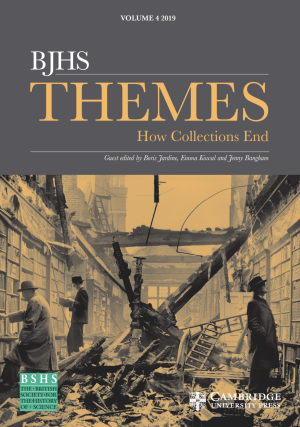Publikationen
BJHS Volume 4: How Collections End
Boris Jardine, Emma Kowal, Jenny Bangham

Collections are made and maintained for pleasure, for status, for nation or empire building, for cultural capital, as a substrate for knowledge production and for everything in between. In asking how collections end, we shift the focus from acquisition and growth to erosion, loss and decay, and expose the intellectual, material and curatorial labour required to maintain collections.
In this introductory essay, we draw together insights from the history of science and from science and technology studies to investigate the dispersal, destruction, absorption, repurposing and repatriation of the diverse scientific collections discussed in the papers that make up this issue of BJHS Themes, and many other collections besides. We develop a distinction first suggested by the curator and bibliographer John Willis Clark between ‘working’ collections of objects valued for the information they hold or produce, and ‘unique’ collections of objects valued for their historical singularity. We show that in many cases, the ‘end’ of an object or collection involves a shift in the dominant account of its cultural value from ‘working’ to ‘unique’ or vice versa. Moving between the laboratory, the museum and difficult-to-classify spaces in between, we argue that ‘ending’ is not anathema to ‘collecting’ but is always present as a threat, or as an everyday reality, or even as a necessary part of a collection's continued existence. A focus on ending draws attention not only to the complex internal dynamics and social contexts of collections, but also to their roles in producing scientific knowledge.